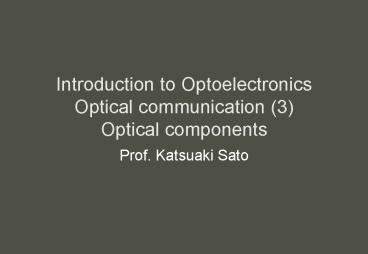Introduction to Optoelectronics Optical communication (3) Optical components - PowerPoint PPT Presentation
Title:
Introduction to Optoelectronics Optical communication (3) Optical components
Description:
Introduction to Optoelectronics Optical communication (3) Optical components Prof. Katsuaki Sato Optical components Previous lectures (1) Optical fibers Transmission ... – PowerPoint PPT presentation
Number of Views:156
Avg rating:3.0/5.0
Title: Introduction to Optoelectronics Optical communication (3) Optical components
1
Introduction to OptoelectronicsOptical
communication (3)Optical components
- Prof. Katsuaki Sato
2
Optical components
- Previous lectures
- (1) Optical fibers
- Transmission of light by total reflection
- (2) Laser diodes
- The pn-junction is forward biased
- Above threshold current lasing occurs
- High density of carriers and photons are confined
in thin active layer (DH structure)
3
Component (3)Optical detectors
- Using photodiode
- Very fast response required
- pin photodiode or Schottky junction photodiode
are used - As material for photodiode InGaAs semiconductors
are used
4
Photodiode
????????????p.152
5
Photodetection
- Pin-PD
- Schottky PD
- Response is determined by capacitance of
depletion layer where photocarrier flows - Thinning of depletion layer and reduction of
junction area is necessary
pin photodiode
Schottky diode
Andrew Davidson, Focused Research Inc. and Kathy
Li Dessau, New Focus Inc.
6
Fundamentals of photodiode
- Illuminate the pn junction
- Electrons and holes are generated by an
excitation across the gap - Generated electrons and holes are separated and
drift to electrodes by diffusion potential
7
Component 4Fiber amplifier
- Light signal traveling in optical fiber for 100
km suffers 20 dB(1/100)attenuation. Therefore the
light intensity should be recovered. Optical
fiber amplifier is used for this purpose. - Optical amplifier consists of an erbium doped
fiber (EDF) and a pumping laser. By introducing
the strong pumping light to EDF the signal light
can be amplified by stimulated emission from Er
ion.
Asahi Glass Company HPhttp//www.agc.co.jp/news/20
00/0620.html??
8
Amplification by Er ion
- EDF absorbs light with wavelength of 980nm
or1480nm and emits infrared light with wavelength
of1530nm. Optical amplification is possible
utilizing stimulated emission of the 1530-nm
luminescence. - Inputting pumping laser light into EDF, Er ion
become excited by absorbing the laser light and
the signal light stimulate to make a transition
to the ground level emitting the light with
wavelength around 1530 nm, which is close to the
signal light wavelength. Thus the incident light
is amplified utilizing the emitted light. - Luminescent intensity and spectrum width differ
from sample to sample according to the
concentration of doped Er-ion. The broader the
bandwidth of the emission band the broader the
bandwidth of communication.
From the Web-site of Asahi Glass Inc.
HPhttp//www.agc.co.jp/news/2000/0620.html
9
Component 5Optical isolator
- Optical isolator is an optical component that
makes the light direction oneway. - Operation of laser diodes (LD) and optical
amplifiers (EDFA) become unstable and generate
noise when returned light enters. - Optical isolator utilize Faraday effect to cut
off the returned beam and stabilize the operation
of lasers and amplifiers.
Shinkosha http//www.shinkosha.com/products/optica
l/
10
Polarization-dependent isolator
analyzer
Magnetic field
Returned beam
polarizer
Faraday rotator
Forward direction
Incident light
Reversed direction
11
Polarization-independent isolator
12
Component 6WDMwavelength division multiplexing
- WDM technique can increase communication capacity
by transmitting many different light signal of
different wavelength simultaneously. - Fiber cables can utilize wavelength region from
1450 to1650nm since the transmission loss is
very low (less than 0.3dB/km) in this region.
13
Optical add-drop
- Optical add-drop can separately drop desired
wavelength from multiplexed-signal network or can
add a particular wavelength to the network
14
Optoelectronic integrated circuits (OEIC)
- Integration of optical and electronic
semiconductor devices - Two types of OEIC exist
- One is integration of light emitting devices
(example LD) and driving FET circuits - The other is integration of optical detection
device like PD and electronic circuits for
amplification and signal processing - Compound semiconductors such as GaAs-based and
InP-based alloy semiconductors are used.
http//www2.nsknet.or.jp/azuma/o/o0028.htm
15
Magneto-optical circulator































